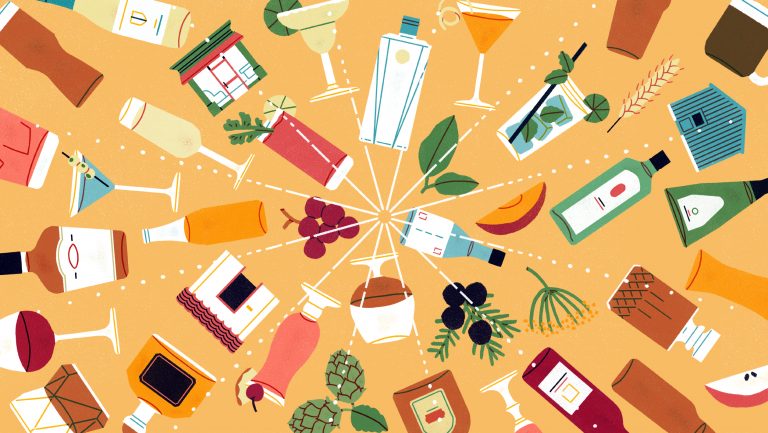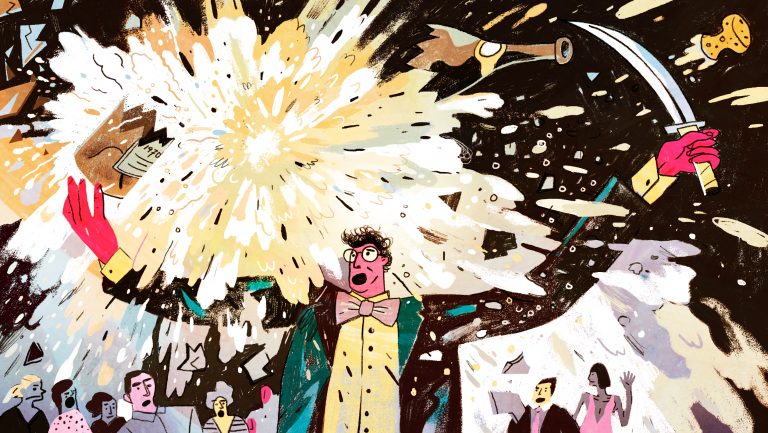“I was the wine director at Daniel’s Broiler on Lake Union in Seattle. The newly crowned Miss Washington State was in with her family to celebrate the title she’d just received, and they wanted to do a Champagne toast. I was young and not as humble as I am now, so of course I offered to saber. They ordered a magnum, a Pol Roger from the 1970s. It was an old bottle, fragile, and a larger format. These all should have been warning flags, but I was young and arrogant and thought I knew it all. All the servers stood around to watch. I took a pass and it sabred okay, but lower than it should have, and one tiny errant shard of glass went flying 90 degrees to the side. I saw it fly through the air just as I saw a server walk forward. It nicked her on the cheek. So I made a server bleed. My name is Segelbaum, and after that night I became “Saber Bomb.” And you’d think I would have learned. Because the year prior, when I was in Miami—like two weeks after I had learned to saber—I had to saber a 3-liter bottle of Champagne. I took the first swipe, nothing. Second swipe, clink, nothing. Third swipe, the neck separated a millimeter. I had changed the structural integrity of the bottle. So I took a fourth pass and the entire bottle exploded. Thankfully, nobody was hurt that time. There was Champagne everywhere, pouring out of my shirt, out of the pockets of my apron. Lesson learned. Today I have specific sabering rules: only young 750s, well chilled, in a standard-shaped Champagne bottle.”
— Erik Segelbaum, corporate wine director, Stephen Starr Restaurants, Washington, D.C.

“Many years ago at Press, I had a customer come in with his large family. He was interested in a certain producer, of which we had a small vertical, something like 2002 through 2010. At that moment in time, the 2007s were really shut down, but as it was the most famous vintage in the vertical, it was the one he wanted. I delicately explained that the wine was going through a bit of a dumb phase and attempted to steer him toward a different, more open-knit vintage. He insisted on the 2007. As I walked away, I heard him explain—loudly—to his table, ‘See? You can never trust sommeliers. They always hoard the best wines for themselves.’”
— Kelli White, former sommelier at Press (St. Helena, California) and Veritas (New York City), senior staff writer for GuildSomm.com, and author of Napa Valley, Then & Now
“I was in Vegas, running the wine program at Caesars Palace, during the heyday of the market, in 2007. We had guys coming to town and spending half a million at the baccarat table. These guys were our bread and butter, the ‘whales,’ so the hotel would give them $70,000 or $80,000 in comps. Grand Cru Bordeaux, Krug, Salon, DRC, they’d try this wine and then that one. It was crazy. It didn’t matter if a bottle was $7,000 … it was all funny money to them. So one night, I had a table of these VIPs ordering old Bordeaux. Our wines were stored down in the catacombs, so it would take me five to seven minutes just to get down there. I got these guys their bottle, did a full decantation service with a candle, and it was corked. So I said, ‘I can try another bottle, another vintage.’ I got a different wine, and the same wine, just in case. I cracked the same wine as before and it was corked as well. The clients didn’t want to try the other one. I was sweating. Now I was 45 minutes in with this table, and I still had a floor full of customers. Then the third bottle they wanted was corked, too. Finally, an hour in, we found a Champagne to start the meal. Those moments—I can’t tell you what it’s like, the nerves. But it’s not our fault—these things happen.”
— Blake Micheletto, sommelier, Toronto, Canada (formerly of Beachcraft, Miami)
“I was working in a restaurant on Nantucket Island. A table ordered a Chardonnay. As I poured a taste for the gentleman, I explained that our wine cooler was not up to snuff at the moment and the wine might need a few minutes in ice. He agreed and angrily sent me away with the bottle. After a few minutes I returned to pour a new taste. He shunned me, saying that no way would it be cold enough yet. I left and intentionally didn’t return for 10 minutes. I asked him again if he’d like to try the wine—which had been in ice and water for a long time now—and he begrudgingly said, ‘Okay.’ I poured him a taste and he shrugged, saying, ‘It will have to do. But bring my wife a cup of ice—she won’t like it.’ As I poured the wine around, he said, ‘Of course, it will never be cold enough, because it started out warm.’ I looked at him in disbelief, wanting to say, ‘Sir, that is not how science works.’”
— Rebecca Chapa, certified sommelier, wine educator, and consultant, San Francisco
“A hundred years ago, when I worked at Michael’s, I presented a red wine to a gentleman in the dining room. I cut the foil off, went to put the corkscrew in, and the bottle slipped out of my hand and hit the floor. Strangely, the whole bottom of the bottle broke right off. It split cleanly, right around, a quarter inch above the base. It didn’t make a big noise, but the wine shot out explosively, leaving a big red circle on the carpet. Needless to say, I was a little rattled after that. I had never seen a bottle break that way before.”
— Paul Sherman, sommelier, Valentino, Santa Monica, California [Editor’s note: Paul Sherman is a relation of SevenFifty’s CEO but was contacted independently by the writer.]
“There was a client who asked me to open, inspect, and decant six bottles of 1999 Château Lafite Rothschild prior to a special dinner he had planned. I did so, and with extreme pleasure, I poured an initial taste for him from the first bottle, in front of his guests, and stood waiting with a wide smile. He turned to look at me after his initial sip, and said, ‘What kind of sommelier are you?’ I said, ‘Excuse me, sir?’ Beratingly, he went on to tell me that the wine was corked, asking me to bring out every single bottle for him to taste (again, in front of his guests). He scoffed at each bottle, insisting that it, too, was corked. I quietly explained the dirty, earthy character that the wine so gorgeously displayed, hoping to help him understand the difference between ‘dirt’ and ‘bacterial.’ After a good 10-minute rant, the client screamed, ‘Take these away and bring out six of your most expensive California Cabs, and throw this trash down the drain!’ Long story short … I did just as he pleased, took the beating he offered me the rest of the evening regarding my sommelier skills, and then enjoyed one hell of a delicious tasting with my staff late that night after closing the restaurant.”
— Leslee Miller, certified sommelier, Amusée Wine, Minneapolis
Katherine Cole is the author of four books on wine, including the new Rosé All Day. She is also the executive producer and host of “The Four Top,” a James Beard Award–winning food-and-beverage podcast on NPR One.

